Planning for a busy summer
Juliet Kennedy, Operations Director at NATS, explores how deploying new airspace, technologies and industry collaboration are helping to manage record levels of air traffic.
This summer looks set to be the busiest ever. We have consistently seen over 8,500 flights a day through our airspace and on the 5th July, we handled a record number of flights – 8,863 – beating the record set the previous year.
And recognising the integral role that UK airspace plays in the European network, we have managed extra traffic through some of our busiest airspace sectors as part of the Joint Enhanced Network Manager and ANSPs Summer 2019 Measures, which as a member of CANSO Europe, we agreed with the Network Manager to improve the performance of the European Air Traffic Management Network.
Despite the additional traffic, delays in UK airspace have reduced compared to last year. We’ve had to work hard to do that. It’s involved deploying new airspace and technologies, and planning that starts months in advance.
Forecasting how many flights we will have to handle is one of the first tasks. Our Airspace Capacity Management team plays a big part, working with partners from across Europe and our airport and airline customers to ensure that the airspace is optimised to minimise delay and maximise efficiency, using a collaborative decision-making process.
And we talk to the military, so we can make the most of our longstanding commitment to Flexible Use of Airspace (FUA), a co-operative approach where sections of airspace are shared by civil and military air traffic.
Collaboration with neighbouring ANSPs, the Network Manager (NM) and customers is vital to ensure that we’re providing the best service possible. This includes a daily ‘UK Network call’ to review the previous day’s operation, with input from the airports and airlines. We also use these calls to talk about the plan for the next day, highlighting the busiest sectors of airspace in the Network, re-route scenarios, forecast weather and any other challenges or risks that may negatively impact the airlines’ schedules.
These calls are in addition to the numerous planning meetings and workshops that have taken place to come up with ways to mitigate against potential delays this summer. This collective approach has resulted in some helpful outcomes, for example, securing 46 slots across 13 UK airports that can be used if we have an event which leads to mass diversions, such as the sudden loss of a runway.
And recognising the frustration of passengers suffering delays, particularly when they don’t understand why, we have undertaken a significant public communications campaign to inform them of the challenges and outline what we are doing to ensure their journeys are not disrupted.
However, parts of our airspace are already at capacity, which is felt even more acutely during the busy summer months. Over the past 12 months, our airspace improvement programme has sought to address some of these constraints by reducing complexity and increasing efficiency through implementation of a series of airspace changes in key areas of our ACCs.
Support to our airspace changes also requires technology changes and in 2018 we completed our implementation of a new electronic computer display system, (ExCDS), which simplifies coordination between air traffic controllers and introduces a conformance monitoring tool. It has improved safety, reduced fuel burn and resulted in record levels of traffic with minimal delay.
We have also deployed enhanced Time Based Separation (eTBS) at Heathrow Airport, building on Time Based Separation, initially developed through SESAR. It effectively offers Heathrow the equivalent of an additional 30 minutes of arrivals per day, helping the airport set a new movement record; ensuring local communities are less affected by late running arrivals; and benefitting the wider European network given the wider impact of the airport’s operation.
In response to our airline’s priorities – and aligned with the UK Government’s Airspace Modernisation Strategy and European ATM Master Plan – NATS improvements will continue. We will deliver the biggest programme of change we have ever undertaken, this includes transformation of our Flight Data Processing and controller working positions and tools, while simultaneously delivering Free Route Airspace and systemisation, providing sustainable capacity and efficiency, while facilitating an additional runway at Heathrow.
In RP3 we will deliver seven major transitions which will require close cooperation with the NM and neighbouring ANSPs to minimise any associated disruption. This will require the NM to ensure that airspace modernisation is a priority across Europe, and take an active role in the coordination of deployments based on established RP3 plans.
All of this is essential if we are to deliver the Single European Sky. And with concerns about climate change increasing calls for action and demand for flying set to continue to grow, working together we need to continue to find innovative solutions to deliver quicker, quieter, cleaner flying.




